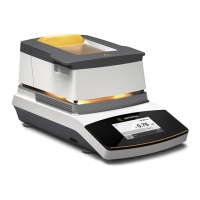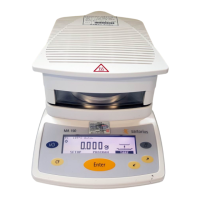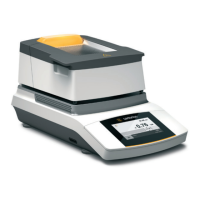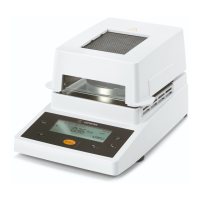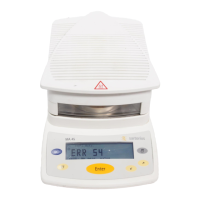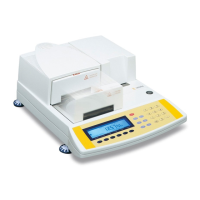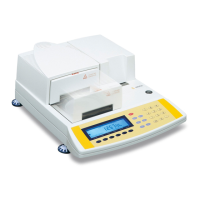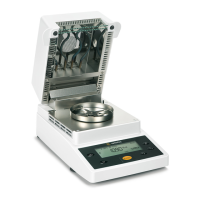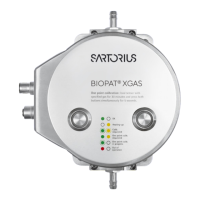Weighing Function
Purpose
The MA100/MA50 moisture analyzer
can be used for quick and reliable
determination of the moisture content
of materials of liquid, pasty and solid
substances according to the method of
thermogravimetry.
Notes on Models MA100C-0CE230V1,
MA100H-0CE230V1:
The models MA100C-0CE230V1,
MA100H-0CE230V1 are delivered with
initial calibration ex factory.
Do not exceed the given ambient
temperature range (+15° to +25°C) stated
on the manufacturer’s ID label. The
verifiable weighing program is designated
by the Q symbol in the display.
To ensure reliable measurements, allow
the analyzer to warm up before switching
to the verifiable weighing program.
An internal calibration/adjustment must
be conducted before each measurement
series (see page 54). This applies until
the analyzer has cooled down to ambient
temperature.
25
Operating the Moisture Analyzer
Basics
The moisture of a material is often
mistakenly equated with its water
content. In fact, the moisture of a
material includes of all the volatile
components which are given off when
the sample is heated, resulting in a
decrease in sample weight. Among
such volatile substances are:
– water
– fats
– oils
– alcohols
– organic solvents
– flavorings
– products of decomposition (when a
sample is overheated)
There are many methods to determine
the moisture content of a substance.
Basically, these methods can be divided
into two categories:
When absolute methods are used, the
moisture content is directly determined
(for example, as a weight loss registered
during the drying routine). These
methods include oven drying, infrared
drying, and microwave drying. All
three of these methods are thermogravi-
metric.
When deductive methods are used, the
moisture content is indirectly determined.
A physical property, which is related to
the moisture in the substance, is measured
(e.g., absorption of electromagnetic rays).
These methods include Karl-Fischer
titration, infrared spectroscopy, microwave
spectroscopy, etc.
Thermogravimetry is the process of deter-
mining the loss of mass that occurs when a
substance is heated. In this process, the
sample is weighed before and after being
heated, and the difference between the
two weights is calculated.
In a conventional drying oven, circulating
hot air warms the sample from the outside
to the inside. Efficiency is lost during
drying because as the moisture evaporates,
it cools the sample surface.
By contrast, infrared rays (IR rays) pene-
trate a sample without being impeded.
Having reached the interior of a sample,
they are converted into heat energy, which
stimulates evaporation, thus drying the
sample. A small part of the IR rays is
reflected from the surface of the substance.
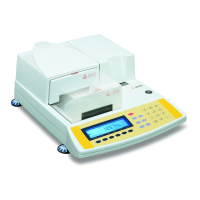
